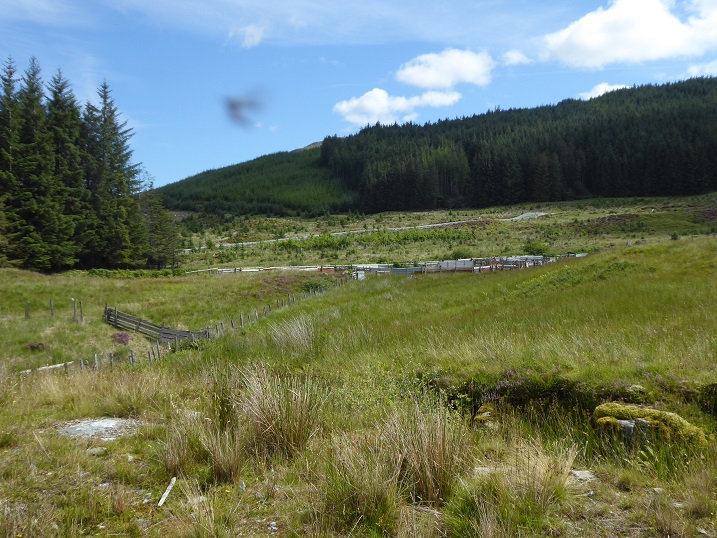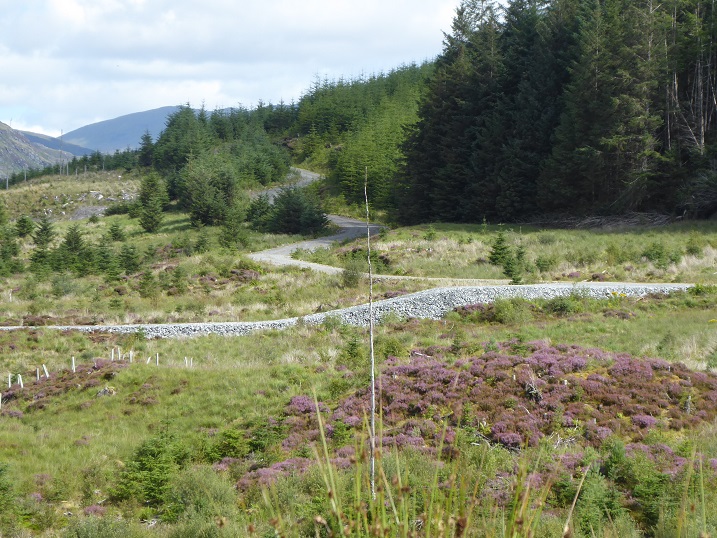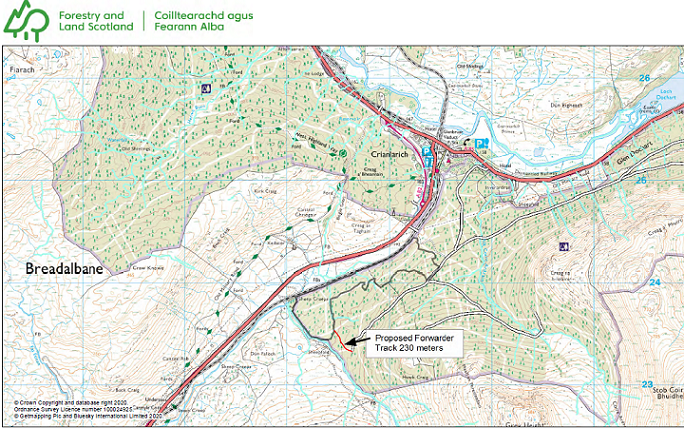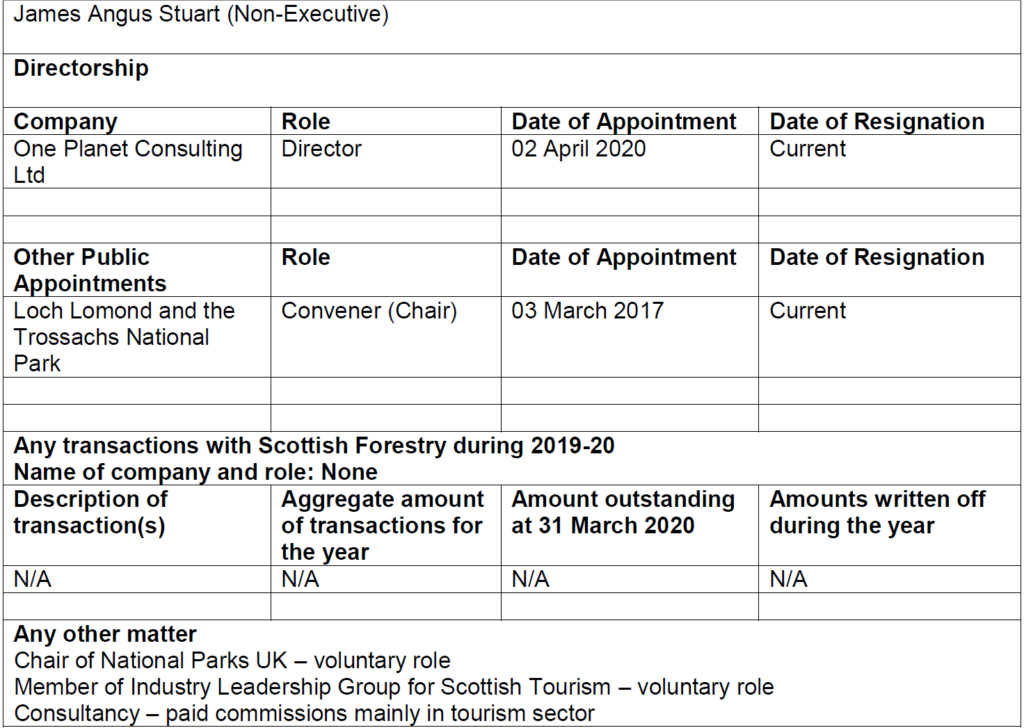
On 6th September, a couple of days before my post More forestry shenanigans – the recently constructed road in upper Glen Falloch, I had written to the Director of Planning at the Loch Lomond and Trossachs National Park Authority asking him to clarify when the track was built and out of what materials. I received a reply on 22nd December (see here for both my email and the reply).
The LLTNPA’s response confirmed the photographic evidence, Forest and Land Scotland (FLS) had constructed this road BEFORE planning staff had had a chance to decide whether Prior Approval was required. Disgracefully, FLS had NOT told LLTNPA staff they had done so. FLS therefore acted unlawfully. In such situations, permitted development rights, as set out in Planning Circular 2/2015 (see here), no longer apply:
“Requirement to comply with conditions and restrictions of Permitted Development Rights.
In order to benefit from PDR a person must comply with all the requirements of the
relevant class as set out in the GPDO [General Permitted Development Order], otherwise the PDR do not apply. This means that where prior notification and approval is required a developer or landowner:
- must submit a prior notification before starting construction or alteration of a
private way; - must not start construction or alteration before the prior notification is
determined, the 28 day period expires or, where appropriate, prior approval is
received; and, - must construct the private way in accordance with the details of the route,
design and method of construction supplied in the prior notification or, where
appropriate, as detailed in the prior approval.”
Three “musts” all breached. Having failed to meet the requirements of the Prior Notification system, this forest road should therefore have required full planning permission.
The LLTNPA response fails to mention this point and also fails to say if they have taken the matter up with FLS, which requested as in my view FLS’ actions were threatening “to undermine the planning system”. This appears to be another example of our public authorities conniving, under the cover of “partnership” working, to undermine the law. It should be a cause of massive concern, both to the general public who care about the countryside and to politicians.
The LLTNPA’s response to me also admits that “the officer’s report of handling (see here) was incorrect to state that ‘no new material was to be used’ as the evidence in my photos showed:

How the officer made this mistake is unclear as the LLTNPA’s response also states that “The application form for this proposal [not available to the public on the LLTNPA planning portal] did confirm that the track would be surfaced with a wearing course to be imported from the nearest FLS quarry”.
The LLTNPA response goes on to add “There is no other ‘specification of works’ available”. That provides more telling evidence of how the LLTNPA are failing to use their planning powers to promote the statutory objectives of the National Park. The whole point of the Prior Notification system, as set out in Planning Circular 2/2015, is that it allows Planning Authority to influence the design of what are otherwise permitted developments, like forest roads, in sensitive areas like National Parks:
3 Requiring planning applications in circumstances where the planning system can add little, or no, value imposes unnecessary costs and causes delays to development. Equally however, if permitted development rights are set too widely, there is a risk of inappropriate development taking place. Concerns have been expressed in recent years regarding the number and scale of private ways
constructed, particularly but not exclusively, where these are located in sensitive upland areas. Landscape, visual and environmental impacts, flooding, drainage and erosion have all been identified as potential concerns [my underlining].
4. The introduction of the prior notification procedure is intended to balance these concerns by providing authorities with a means of regulating, where necessary, important aspects of agricultural and forestry development for which an application for full planning permission is not required by virtue of the the GPDO. Prior notification is therefore an important tool in preventing inappropriate
construction of private ways.”
Once notified of an otherwise permitted development, like a forest road, through the Prior Notification system, a Planning Authority can then require Planning Approval. This allows Planning Authorities to influence the design details:
“Prior approval allows the PA to consider the proposed design and manner of construction of the private way, the details of the materials to be used and the route, and to request any amendments they consider necessary to these details in the context of its setting. Where amendments are considered necessary it is expected that the planning authority will require that the private way is constructed or altered in accordance with the amended details that they approve.”
LLTNPA planners, however, decided Prior Approval was not needed. In my view, the photos speak for themselves, this short road has a significant impact on the landscape and environment in upper Glen Falloch. The LLTNPA dismissed this in their report on the Prior Notification stating “There is not considered to be visual impact on the landscape from the village of Crianlarich”. A quick look at the map accompanying the retrospective “Prior”Notification should have told them this is nonsense:

Crianlarich is two kilometres away, out of sight over the col separating Glen Falloch from Strath Fillan and separated from the village by large blocks of conifers.
What matters is the view from Upper Glen Falloch, which is popular with hillwalkers which the LLTNPA failed to consider. There, as I pointed out in my earlier post, the LLTNPA has rightly required Glen Falloch Estates to undertake restoration work on their botched hydro track, so why are they allowing Forestry and Land Scotland to get away with different standards on the other side of the river?
In a further indication that it has abdicated its planning responsibilities, the LLTNPA’s response to me states:
“This track is we understand to be temporary and the above land management plan confirms that, when no longer needed for extraction of timber, the width will be narrowed and the surface allowed to green over”
This tells you that the LLTNPA decided FLS could go ahead with this road without Prior Approval without even having established whether it would be permanent or temporary. While now claiming its temporary, the LLTNPA then contradict themselves by stating that when no longer needed it will be narrowed – by how much and what will happen to all the aggregrate? – and then allowed to “green over”. It looks as if any restoration will be just left to nature. The LLTNPA have completely ignored the longer-term impacts that dumping aggregate onto soils to create the new road will have on their ability to absorb carbon and on ecosytems.
Having failed to ask for any documentation, the LLTNPA now have no recourse should FLS decide to do something different. So far, none of the erroneous documentation on the Planning Portal has been corrected.
There is nothing in either the planning report or their response to me to suggest that the LLTNPA Planning Department is doing anything to further the Park’s statutory conservation duty. Instead, this case provides further evidence that the Prior Notification system for forest tracks is not working and the LLTNPA are in cahoots with Forest and Land Scotland.
Regular readers may recall that James Stuart, Convener of the LLTNPA, is also paid to be a member of the Scottish Forestry Strategic Advisory Group (see here), which regulates the whole industry:

While James Stuart may not have done any commercial business with Scottish Forestry in 2019-20, what this declaration fails to say is that in 2019-20 the LLTNPA approved its Trees and Woodland Strategy (see here for posts). This gave a green light to FLS and other forestry interests to apply the same standards to their forest operations in the National Park as they do elsewhere. That strategy undermines even the weak protections offered by the Prior Notification system which advocates that, in sensitive areas like National Parks, Planning Authorities:
” will also need to consider issues such as; the visual effect of the development on the landscape, flood risk, the impact on local amenity and environmental impacts to soils and the water environment, including wetlands.”
I will now write to Mr Stuart asking that he takes up the failures evident in this case both with his own staff and with Forestry Scotland. He is ideally placed to change the current set-up which allows industrial forestry practices, which have trashed so much of the National Park, to continue unabated.

I find the name of the company ‘One Planet Consulting’ to be ironic but disappointingly typical of so many businesses which try to pick names which give the (false) impression that they are an environmentally conscientious concern when all too often the business is simply hiding its true credentials behind connotations of being caring and trying to minimise their impact.
On One Planet’s main page, the link to ‘Services’ brings you to the second paragraph from which I quote: “ Our services have all be developed to help you chart these challenging waters and to drive greater returns from your organisation” – which is business speak, in my book, for ‘ we know how to help you avoid tedious and obstructive regulations so that you can maximise your profit potential…which of course we will take a cut.
We can ignore the typo of ‘be’ instead of ‘been’ but not the claim to be able to help folk get round ‘challenging waters’ – aka: legislation which seeks to put a stop to the wholesale environmental rape of natural resources.
This is scandalous. I am disappointed with the people who are employed to look after LLTNP and make these decisions. They are supposed to be looking after the National Park to save the enviroment, forrestry, climate change, for the people of these areas.
Efforts to persuade successive governments to bring hill tracks under proper regulation through the planning system have been under way since the 1960s when Adam Watson first documented their impact on wild areas of the Cairngorms in his usual meticulous, scientific way.. All governments have subsequently failed to address the problem correctly. The last effort, directed at the then SNP planning minister, Derek Mackay, failed and resulted in the worst SNP planning decision since the SNP came to power in 2007. On a site visit to the Pentlands to look at unauthorised construction of hill tracks with Mackay and his officials it was obvious to me that neither he nor his officials had a clue about the problem and how to deal with it. It was equally obvious that officials in Forestry Commission Scotland were putting pressure on Mackay to avoid any regulation of such tracks. So we finished up with the useless Prior Notification system. Even that is ignored by farmers and foresters across Scotland, as we see in the national parks and elsewhere. Come next May we need to ensure that the only MSPs elected to serve in the Scottish Parliament are committed to the introduction of full planning control over all hill tracks used by motorised vehicles. At least we can be confident that Mackay, disgraced in several ways, will not be amongst these MSPs, a small mercy.